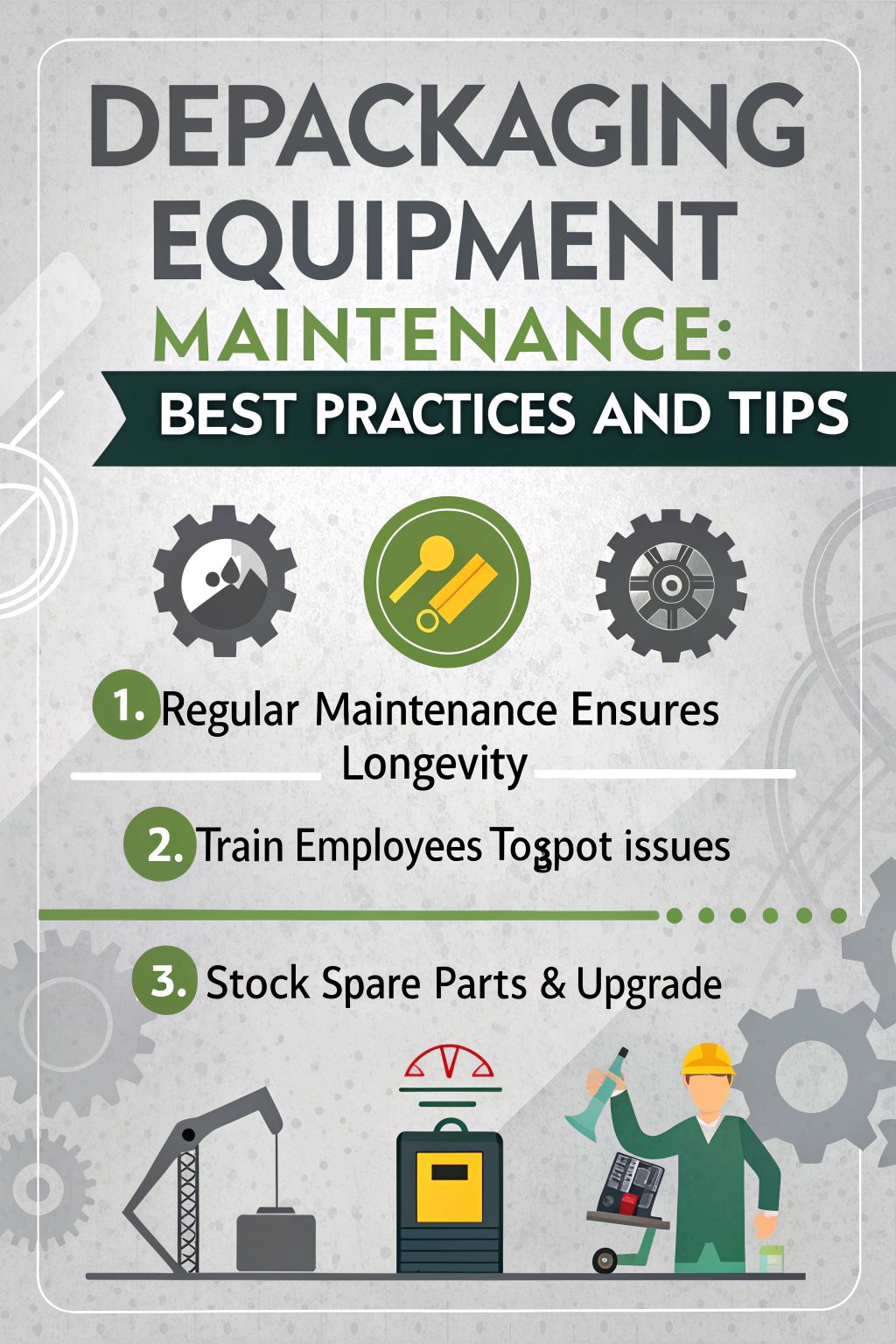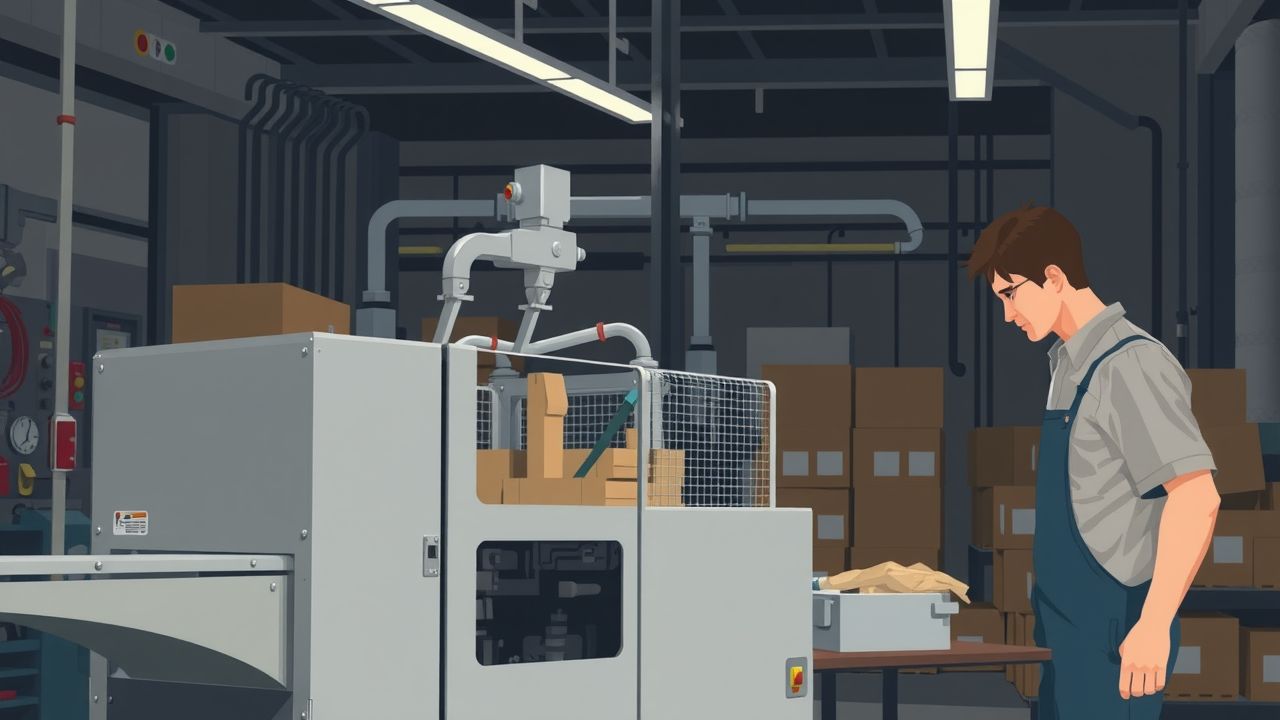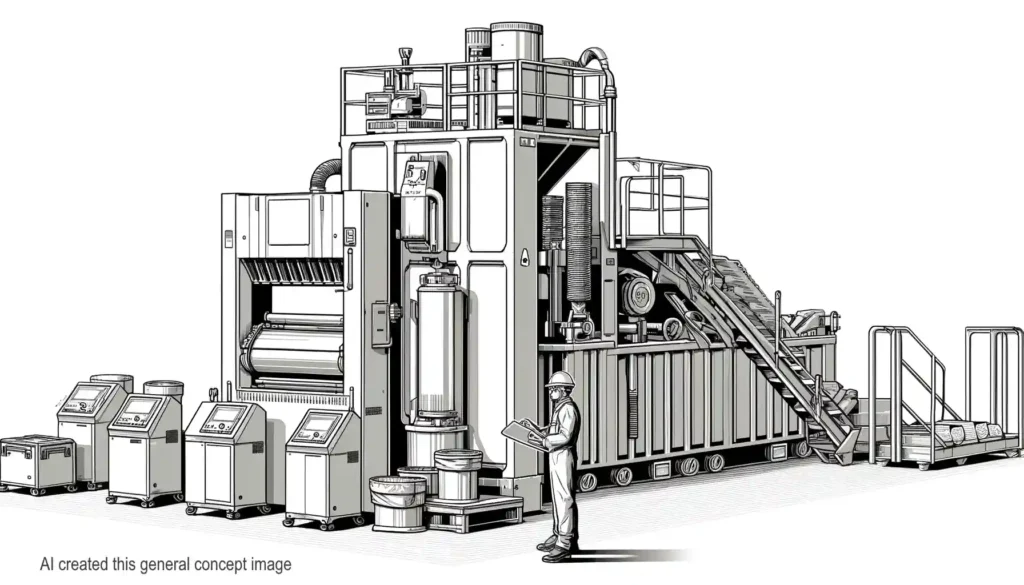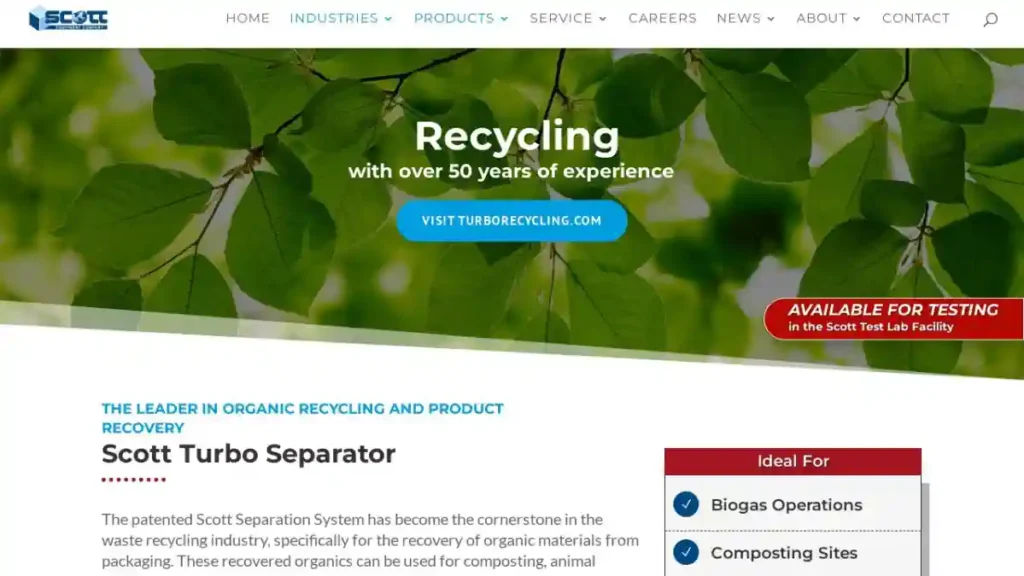Maintaining depackaging equipment can be a big headache. Machines break down, causing delays and high costs. If you deal with packaging machines daily, you know how frustrating it can be when they stop working.
One important fact: Proper maintenance is key to keeping your machines running smoothly. This includes regular checks, cleaning, and changing worn-out parts.
In this blog post, we will explore the best practices for maintaining your depackaging equipment. We will cover preventive strategies and tips for long-term care. You’ll find practical advice to help avoid costly repairs…
Read on!
Key Takeaways
- Regular Maintenance is Crucial: Regular checks, cleaning, and replacing worn-out parts help keep machines running smoothly.
- Employee Involvement Matters: Train workers to spot issues early. They can handle basic tasks like daily cleaning and lubrication.
- Plan for Long-Term Care: Keep spare parts in stock and upgrade old components when needed to avoid downtime.

Preventive Maintenance Strategies

Preventive maintenance is key to keeping depackaging equipment in good shape. It helps avoid costly repairs and downtime… enhancing productivity on the production line.
Adhering to a Scheduled Maintenance Plan
Maintaining depackaging equipment is crucial for smooth operations. A scheduled maintenance plan is essential to ensure this.
- Set Routine Maintenance: Create a clear schedule based on usage or time. Regular intervals prevent unexpected failures.
- Follow Manufacturer Guidelines: Use the equipment maker’s manual. They provide specific preventive maintenance tasks like cleaning and lubrication routines.
- Track Performance: Monitor the equipment’s health. Early signs of wear and tear can be easy to miss but are vital for long-term care.
- Document Everything: Keep detailed records of all maintenance activities. This helps in planning future actions and spotting recurring issues.
- Regular Inspections: Inspect key parts regularly, such as induction sealers and compressed air systems. Early detection avoids costly repairs later on.
- Calibrate Equipment: Ensure machines are calibrated correctly at all times for optimal function and energy consumption efficiency.
- Stock Spare Parts: Maintain an inventory of spare parts needed frequently. This reduces downtime when replacements are necessary.
- Train Employees: Ensure staff know how to operate and maintain the machine properly daily, from cleaning duties to basic troubleshooting tasks.
- Lubrication Schedules: Follow set intervals for applying lubricants to moving parts, preventing unnecessary friction and damage.
- Energy Checks: Periodically assess energy consumption to spot inefficiencies that may indicate a need for maintenance or upgrades.
- Plan Upgrades Wisely: Replace obsolete components before they fail completely, ensuring the system remains up-to-date with current standards.
Regular Cleaning and Lubrication
Regular cleaning and lubrication are key to keeping depackaging equipment in top shape. These tasks reduce friction, prevent wear, and ensure smooth operation.
- Daily Cleaning: Clean the machine every day. Remove dust, residues, and any packaging materials stuck in the equipment. Use a soft brush or cloth.
- Lubrication Schedule: Follow a strict lubrication plan. Lubricate all moving parts at regular intervals. This prevents friction and reduces wear.
- Check Oil Levels: For machines with oil reservoirs, check oil levels daily. Top up as necessary to maintain optimal performance.
- Inspect Seals and Gaskets: Inspect seals and gaskets for any signs of wear or leaks during cleaning. Replace them immediately if damaged.
- Clean Filters Regularly: Clean or replace filters often to avoid clogging which can lead to overheating or failure.
- Monitor Wear Parts: Keep an eye on high-wear parts such as blades, belts, and gears. Replace these parts before they fail to avoid costly downtime.
Following these steps ensures that your depackaging equipment remains efficient and reliable.
Autonomous Maintenance Tasks
Autonomous maintenance involves assigning simple upkeep tasks to equipment operators. This promotes machine inspection and helps in spotting issues early on… reducing costly downtime.
Employee Involvement in Daily Checks
Employee involvement in daily checks boosts equipment reliability. Front-line workers can spot issues early. They manage basic maintenance tasks, which cuts costs and prevents bigger problems.
Regular checks ensure the machines stay clean and function well.
Training is key for these tasks. Workers must know what to look for during inspections. This reduces downtime and extends the life cycle of machinery. Engaged employees make a big difference in packaging machine upkeep.
Empowering employees with maintenance tasks fosters responsibility and efficiency.
Quick Identification and Resolution of Issues
Quick identification of problems is crucial in depackaging equipment maintenance. Autonomous Maintenance (AM) helps with this by involving front-line workers. These workers spot issues early, ensuring quicker fixes and reducing downtime.
Key activities like abnormality management support fast problem detection.
A Computerised Maintenance Management System (CMMS) also assists here. It centralises maintenance schedules and reporting tasks, making it easier to respond quickly to any issues. With a CMMS, teams can act promptly, keeping the packaging machine running smoothly without delays or increased costs.
Planning for Long-Term Equipment Care
Long-term equipment care is crucial for the efficiency and lifespan of your depackaging machines. Plan ahead by identifying which parts require frequent replacement and keeping them in stock.
Understanding Spare Parts Management
Understanding spare parts management is crucial. OEMs (Original Equipment Manufacturers) provide a list of recommended spare parts for de-packaging machines. These parts fall into three categories: A, B, and C.
Category A includes high wear parts with shorter life cycles and longer lead times. Keeping these in stock can prevent downtime during production. Category B consists of medium wear parts that have a longer life cycle and may not fail often.
Category C covers low wear parts that should never fail.
Maintaining an adequate supply of critical spare parts ensures uninterrupted operation – Industry Expert
Spare part strategies reduce maintenance costs by avoiding sudden breakdowns—leading to smoother operations and better workflow efficiency.
Upgrading and Replacing Obsolete Components
Upgrading and replacing obsolete components is crucial. It helps keep your machines efficient and compliant. Here are best practices for doing this:
- Communicate with Manufacturers: Stay in touch with machine makers. They inform you about necessary upgrades.
- Monitor Maintenance Costs: Upgrade when repair costs hit 50% of new machine prices. It’s a good rule of thumb to follow.
- Use Predictive Maintenance: This method can save 30-40% on future repairs. It detects issues early, preventing major breakdowns.
- Stock Spare Parts: Always have key parts in stock. Quick fixes reduce downtime and keep operations smooth.
- Regularly Check for Obsolete Parts: Technology evolves fast—review components often to spot outdated ones.
- Plan for Long-Term Care: Have a long-term strategy for machinery care and upgrades. This avoids sudden expenses and disruptions.
- Train Staff on New Components: Ensure all employees understand any new parts or systems installed. Training boosts efficiency.
- Follow Regulations: Abide by industry rules to avoid fines or safety risks when upgrading equipment.
- Schedule Upgrades During Downtime: Plan updates when the machines aren’t in use to minimise disruptions.
- Document All Changes: Keep thorough records of upgrades and replacements for accountability and future reference.
Navigating Regulations and Standards in Depackaging Equipment Maintenance
Sticking to regulations is vital. It ensures your depackaging equipment stays in top shape and legal clearances remain intact. Regular maintenance, as required by health and safety rules, keeps the workplace safe from hazards like leaks or emissions.
Ignoring manufacturer’s recommendations can void warranties and raise liability.
Environmental compliance is just as crucial. Proper care prevents environmental risks such as spills that could harm the surroundings. Always follow guidelines set by local authorities to avoid fines and maintain a good reputation.
Stay updated on industry standards—keeping equipment calibrated and tamper-evident seals intact shows commitment to these essential practices.
Conclusion
Maintenance of depackaging equipment is vital for efficiency. Preventive care and regular checks ensure smooth operation. Plan for long-term care to avoid surprises. Stay updated on regulations and standards.
Proper maintenance saves time, money, and headaches—keeping your equipment running well!
For more insights on adhering to the latest compliance guidelines, visit our detailed guide on navigating regulations and standards in depackaging equipment maintenance.
FAQs
1. What is preventative maintenance for depackaging equipment?
Preventative maintenance involves regular checks and servicing of your depackaging equipment to prevent breakdowns. This includes inspecting components like shrink-wrap mechanisms and capsules, ensuring they function properly.
2. How often should I perform packaging machine maintenance?
Perform routine packaging machine maintenance at least once a month. Regular calibration of flexible packaging systems helps maintain efficiency and reduces downtime.
3. Why is calibration important in maintaining depackaging equipment?
Calibration ensures that all parts of the machinery work correctly, which is vital for handling different types of flexible packaging and capsules accurately. Proper calibration can extend the life of your equipment.
4. What are some tips for effective learning about depackaging equipment maintenance?
Start by reading manuals provided by manufacturers—these offer specific guidelines on preventative maintenance tasks like checking shrink-wrap settings or calibrating sensors. Attending training sessions can also enhance your understanding and skills in maintaining these machines effectively.
References
- https://fiixsoftware.com/maintenance-strategies/preventative-maintenance/
- https://limblecmms.com/blog/7-preventive-maintenance-best-practices/
- https://fatfinger.io/best-practices-for-equipment-care-and-maintenance/ (2024-08-30)
- https://www.oil-store.co.uk/blog/three-best-practices-for-lubrication-maintenance/
- https://facilio.com/blog/autonomous-maintenance/
- https://tractian.com/en/blog/spare-parts-management
- https://limblecmms.com/blog/spare-parts-management/ (2024-05-10)
- https://www.linkedin.com/pulse/best-practices-maintaining-upgrading-your-machinery-assets-0ljhc
- https://www.researchgate.net/publication/353147884_The_Importance_of_Equipment_Maintenance_Forecasting
- https://www.sasystems.co.uk/2024/03/18/navigating-legal-obligations-maintaining-your-equipment/ (2024-03-18)
Discover more from IPPTS Depackaging Equipment Insights
Subscribe to get the latest posts sent to your email.








